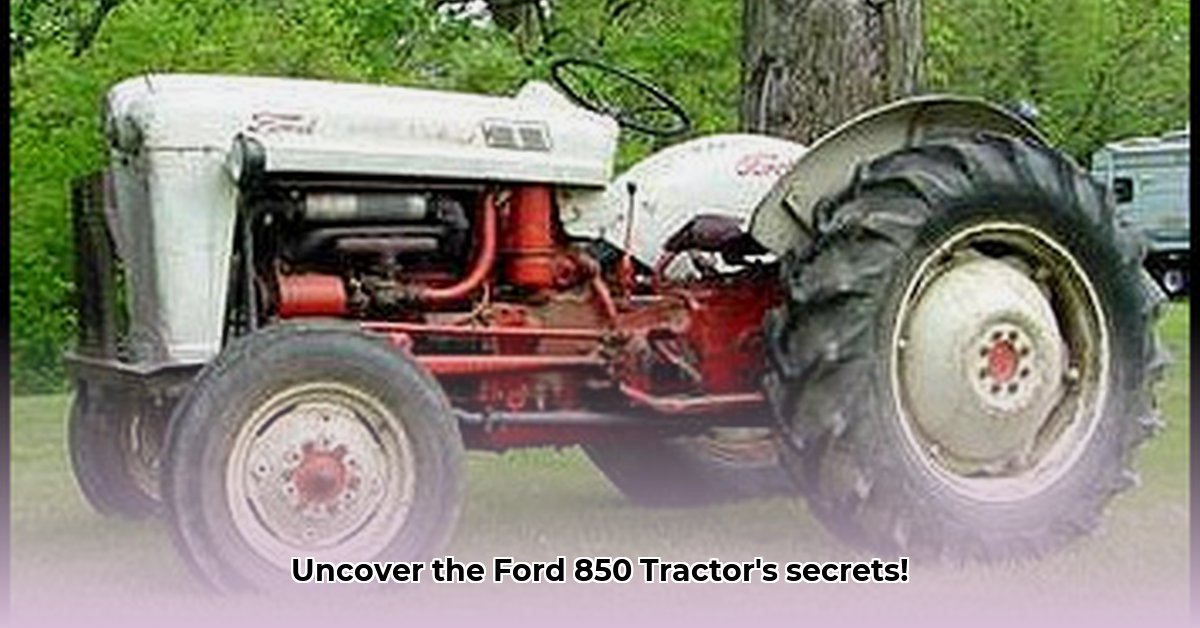
The Ford 850 tractor. While not a household name like some modern behemoths, it represents a pivotal moment in agricultural history, a testament to ingenuity and the dawn of mechanized farming. This deep dive explores its historical context, technical specifications, operational nuances, and the joys (and challenges) of restoration, appealing to historians, collectors, and enthusiasts alike. For more on similar Ford tractors, check out this resource on the 1968 Ford 2000.
A Legacy Forged in the Fields: The Ford 850's Historical Context
The 1950s witnessed a dramatic shift in agriculture. Horses and oxen, the backbone of farming for centuries, were increasingly replaced by the power of the internal combustion engine. Tractors became indispensable, and the Ford 850, produced from 1954 to 1957, played a significant role in this mechanization. It represented an accessible and reliable option for farmers transitioning from animal power to mechanized farming, boosting efficiency and yields. How did the Ford 850 impact individual farms and the overall agricultural landscape of the era? This shift wasn't just technological; it was a societal one, altering the rhythm of rural life.
Deconstructing the Workhorse: Ford 850 Tractor Specifications
The Ford 850, though undeniably a product of its time, possessed a robust design. Its 2.8-liter engine, capable of approximately 40 horsepower, provided a significant boost over animal power. Fuel flexibility was a key feature, with the option of running on gasoline or Liquid Petroleum Gas (LPG), reflecting the prevalent fuel choices of the era. The transmission was a 5-speed manual, unsynchronized, requiring a bit more finesse than modern counterparts. A power take-off (PTO) shaft further enhanced its versatility, enabling it to power a range of implements. Braking relied on mechanical expanding shoe brakes, a contrast to today’s sophisticated hydraulic systems. The tractor's compact size made it suitable for a variety of farming tasks.
Here's a concise summary of its key specifications:
| Specification | Detail |
|---|---|
| Engine | 2.8-liter, four-cylinder |
| Fuel | Gasoline or LPG |
| Horsepower | Approximately 40 hp |
| Transmission | 5-speed manual, unsynchronized |
| PTO | Yes |
| Brakes | Mechanical expanding shoe brakes |
| Hydraulic System Capacity | 2 gallons |
Operating Your Ford 850: A Guide for Enthusiasts
Owning a classic tractor like the Ford 850 is an engaging experience, but responsible operation and diligent maintenance are paramount. Regular maintenance is key. Consult your owner's manual (if you're lucky enough to find one!) for specific recommendations regarding fuel type, oil viscosity, and lubrication schedules. Regularly check fluid levels, tighten any loose bolts or nuts, and meticulously clean the air filter. Preventive maintenance is far less costly than emergency repairs.
Weighing the Pros and Cons: Ford 850 Strengths and Weaknesses
The Ford 850, while a significant advancement for its time, possessed both advantages and drawbacks compared to contemporary and modern tractors. Its simplicity was a major benefit—fewer complex parts equated to fewer potential points of failure and simplified maintenance. However, its lower horsepower and rudimentary features limited its versatility compared to later models.
Strengths:
- Simplicity of design, leading to relatively easy maintenance and repair.
- Reliable performance for basic farming tasks of its era.
Weaknesses:
- Lower horsepower compared to modern counterparts, affecting productivity.
- Unsynchronized transmission, demanding more skill and care during gear changes.
- Limited hydraulic capacity compared to modern systems.
- Open operator station, offering minimal protection from the elements.
The Collector's Corner: Finding, Restoring, and Maintaining Your Ford 850
The Ford 850 is gaining popularity among collectors, who appreciate its historical significance and charm. Sourcing parts can be challenging but rewarding. Online forums dedicated to Ford tractors, such as MyTractorForum, are invaluable resources for connecting with fellow enthusiasts, discovering parts, and exchanging restoration tips. Original manuals are rare and highly sought after, providing invaluable insight into the intricacies of the machine. Restoring a Ford 850 is a labor of love, a journey combining mechanical aptitude, dedication, and a deep appreciation for agricultural history.
A Timeless Legacy: The Enduring Appeal of the Ford 850
Despite its age and seemingly basic design, the Ford 850 remains a significant symbol in the history of agricultural mechanization. It played a crucial role in the transition from horse-drawn implements to mechanized farming, undeniably influencing the development of more advanced machines. Its enduring appeal resides in its robust simplicity, its role in agricultural history, and its potential for restoration and continued use. The Ford 850’s story is a reminder of the continuous evolution of farming technology and the enduring legacy of this iconic machine.